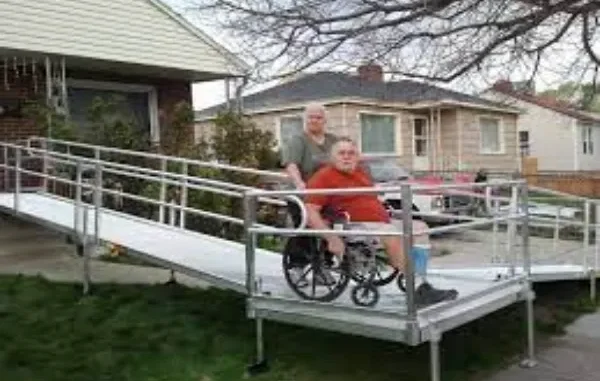
Home is our sanctuary, the place where we can relax, express ourselves, and feel truly comfortable. But for millions around the world who rely on wheelchairs for their mobility, “home” becomes more than just a place of solace—it must also become an extension of their capabilities. For wheelchair users, the layout, features, and overall accessibility of their home can have a profound impact on their independence and quality of life.
Wheelchair users must often make specific home modifications to ensure they can move around and perform daily tasks safely and efficiently. In this comprehensive guide, we look at the critical home modifications that can transform a standard living space into a safe, functional, and welcoming environment for individuals using wheelchairs.
Wheelchair-Accessible Entrances
When it comes to entering and navigating the home, a few key modifications can make a world of difference.
Ramps
The first hurdle someone in a wheelchair might face is simply getting in the door. Installing ramps at all entry points is a game-changer, enabling independent access and reducing the reliance on others for assistance.
Ramps come in various styles, from permanent concrete ramps to portable aluminum ones, and can be tailored to meet the specific needs of the individual and their home environment. A well-constructed ramp not only provides smoother entry but also reduces the risk of falls.
Widened Doorways
Standard doorways are often too narrow for wheelchairs to pass through comfortably. Widening doorways can allow for easier navigation and decreased strain on the wheelchair user. In addition, it’s beneficial to remove thresholds or install ramps over them to prevent the wheelchair from getting stuck or jostled.
Elevators
For individuals residing in multi-story homes in Boise, ID, the installation of a residential elevator can ensure access to all parts of the house without having to deal with the challenge of stairs. While this modification is more involved and costly, it can provide an unprecedented level of freedom and convenience.
Accessible Bathrooms
The bathroom is one of the most potentially hazardous areas of the home and requires thoughtful modifications to accommodate wheelchair users safely.
Roll-in Showers
Converting traditional showers into roll-in showers ensures easy and safe access for wheelchair users. Zero-threshold shower pans allow for smooth entry, and the absence of a curb reduces the risk of tripping and falling. Handheld showerheads and benches offer comfort and functionality during use.
Grab Bars
Strategically placed grab bars in the shower, next to the toilet, and around the sink area can provide stability and support. They should be securely installed and able to bear the weight of the individual to help them move in and out of the shower or bathroom stall confidently.
Kitchen Modifications
The kitchen is the heart of the home, and it is essential to adapt this area for use by all members of the household.
Lowered Countertops
Lowering the height of countertops allows wheelchair users to prepare meals and use standard kitchen appliances without architectural barriers. This adjustment should be customized to the individual’s height and reach, ensuring maximum comfort and efficiency.
Accessible Sinks
Sinks with open space below, or side-mounted sinks, provide wheelchair users with close and unobstructed access. A single lever or touchless faucet makes controlling water flow and temperature much more manageable, and under-sink safety covers can prevent accidental burns or painful contact with hot pipes.
Flooring Considerations
The right flooring is crucial to a wheelchair user’s ability to move around the home independently and safely.
Non-slip Surfaces
In areas prone to wetness or spillage, installing non-slip flooring significantly reduces the risk of falls for both the wheelchair user and anyone else in the home. Consider materials like textured tiles, rubber, and high-quality vinyl that offer traction and are easy to clean.
Carpet Removal
High-pile or plush carpets can be challenging for wheelchairs to maneuver across and may cause wear and tear on the wheelchair itself. When possible, replace the carpet with smooth flooring. In areas where carpet is preferred, low-pile carpet or carpet tiles are a better option.
Technology Integration
Today’s technology not only entertains but also empowers those with physical limitations to control their environment with greater ease.
Smart Home Devices
From smart lighting to thermostats, smart home devices can be controlled remotely or with voice commands, providing wheelchair users with more independent control over their environment. Features like adjustable lighting levels and automatic door openers can make a significant difference in comfort and convenience.
Voice-Activated Controls
Voice-activated systems can offer hands-free access to various home features, making it easier for wheelchair users to operate electronics, request assistance, or perform tasks without having to manipulate physical controls.
Conclusion
Home modifications for wheelchair users are not just about creating physical accommodations; they are about fostering independence and enhancing the overall quality of life. Every individual’s needs are unique, and home modifications should be tailored to ensure that they not only meet immediate accessibility requirements but also allow for a comfortable and fulfilling lifestyle.
By making the right adjustments, a wheelchair user can maintain their sense of self-reliance and move about their home with ease and confidence. Keep exploring ways to make your living space safe, accessible, and welcoming for all individuals.
Leave a Reply